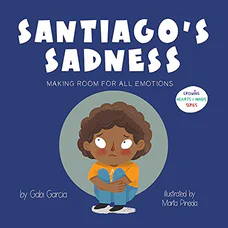Santiago’s Sadness
Making Room for All Emotions
Written by Gabi Garcia
Illustrated by Marta Pineda
39 pages
•
Published 2021 (Skinned Knee Publishing)

Recommended Age Range: Elementary-aged kids. Older kids will understand the depth of the story better than younger ones, but this story does such a nice job describing a complicated but important concept in an accessible way that many younger children will get a lot out of it too.
Publisher's Summary:
Santiago didn’t feel like smiling. He didn’t feel like playing. Ever since his family moved, Santiago didn’t feel like doing much. “Moving isn’t a big deal,” he told himself, but after meeting Lucia at his new school, Santiago begins to understand that it’s okay to feel sad. Slowly, Santiago begins to unpack his sadness and learns that the dark clouds will be followed by sunshine again.

Dr. Annie's Takeaways
Recommended for: This book portrays the importance of sitting with and “unpacking” our feelings rather than avoiding them. It is excellent to read with children who think that feeling sad is wrong, weak, useless, or scary and therefore minimize what they’re feeling and/or who avoid thinking about or sharing their feelings. It’s also great for a child who is feeling sad about a family’s move (as Santiago is), but it’s certainly not limited to this specific situation. This story is available in Spanish as well as English.
Would a child like it? A child who is sick of people telling them to think positively, put on a smile, etc. will feel validated and seen by this book. A child who is trying their best to put on a brave face when they’re struggling underneath will feel hopeful for the relief this book maps out.
Tone: Thoughtful, honest, kind
Story Quality: This is such a lovely, necessary book. It gently pushes back against “look on the bright side” culture with the message that “paying attention to the dark clouds helps us appreciate the sunshine.” Santiago and his story are believable and engaging. This is a children’s book that believes children can and should be trusted with big feelings and big ideas.
Illustrations: Modern-looking colorful cartoons that are a bit funny at times and emotionally resonant (e.g., The first page starts, “Santiago walked to school slowly. He didn’t feel awesome” as he walks past an aggressively positive sign that says, “Everything is awesome!”).
Representation: Santiago appears to be a Latino boy with brown skin and brown curly hair. He befriends a girl named Lucia who appears to be Latina and/or Black. Santiago has a mom and a dad who both have brown skin and dark brown hair, as well as an Abuelo. Santiago goes to school with diverse classmates, and his best friend is pictured as a White boy with red hair. Santiago lives in a house in a large city. Of note, this book is also available in Spanish.
Psychological Practices: This book demonstrates how minimizing one’s feelings and always trying to “look on the bright side” (i.e., “packing away” one’s feelings–I appreciate the effectiveness of this metaphor and its relevance to the moving theme in this story) actually contributes to feeling worse rather than better. Santiago learns from his friend Lucia that he can acknowledge his sadness and let himself feel it, that he can draw and write about it, and he can talk with a loved one about it (i.e., unpacking his feelings), and that these things will lead to him being better able to adjust and to feel better.
Concerns: Nothing
